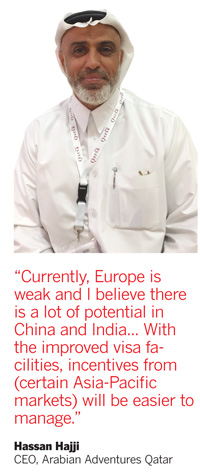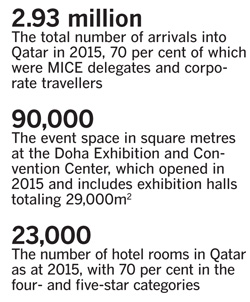
More programmes and mid-tier accommodation are surfacing in Qatar as the trade hones in on new and traditional MICE markets. By Caroline Boey
Qatar, host of the 2022 FIFA World Cup and the first country in the Middle East to clinch the event, is banking on MICE and events travel to fulfil the Qatar National Tourism Sector Strategy 2030 as the kingdom embarks on the diversification of its economy.
According to the Qatar Tourism Authority (QTA), MICE accounted for 70 per cent of the nearly three million visitors Qatar welcomed in 2015 and the number is expected to grow threefold to nine million in the next 15 years.
The opening of the new Doha Exhibition & Convention Center in 2015 along with the Qatar National Convention Centre are expected to attract a major increase in meetings, exhibitions and other events.
A senior spokesperson with QTA added that the destination’s tourism strategy is in place to secure long-term economic viability through an increase in hotel capacity to meet what’s required for the upcoming 2022 FIFA World Cup.
He said: “Now, 70 per cent of hotels are in the four- and five-star category. But there will also be a substantial increase in three-star and serviced residences opening in 2019 to meet the needs of the Gulf Cooperation Council (GCC) markets, which may also suit other markets,” he noted.
Qatar is investing an estimated US$45 billion on hotel and resort development until 2030 and the four- and five-star room boom kicked into high gear in 2015 with some 4,000 new keys added and more in the pipeline.
Another strategy the QTA is adopting is to market the culture and authenticity in the destination, which could enhance MICE experiences with a “sense of place”, added the spokesperson.
In Asia, QTA has been working on increasing the small base of MICE visitors from Singapore and Malaysia in the last two years and will begin to focus on China in 2017 to extend its reach beyond the traditional GCC countries and European markets like Germany, Austria, Switzerland, France and the UK.
The QTA spokesperson said: “We increased our B2B partnership in Singapore, Malaysia and Hong Kong over the last two years and there was a 14 per cent increase across the markets.”
And to tap China, Qatar has launched a visa-free scheme for Chinese travellers with up to four days in transit and will make available online visa applications in 2017 to leisure and MICE travellers.
DMC Arabian Adventures Qatar, established in 1987 ,
,
has been tapping the Asian market for almost a decade and CEO Hassan Hajji observed: “Currently, Europe is weak and I believe there is a lot of potential in China and India. For us, international MICE is still very small but with the improved visa facilities, incentives from Malaysia, Singapore, South Korea, Japan, Australia and New Zealand will be easier to manage.”
Other players interviewed expressed that Asia had not previously been a major focus, but is quickly gaining in importance.
Gulf Adventures, set up in 2000, has been handling small Asian incentives (25-30 pax) and larger corporate meeting groups from China and Singapore (60-65 pax).
Tare Helmy, director of sales, told TTGmice that business from Asia, comprising about 200 to 300 travellers a year, is quite a small part of its overall clientele, but the DMC has big plans for some of its promising markets.
“The outlook from Asia shows that China offers the biggest potential and we are planning to appoint a representative in Shanghai,” said Helmy.
He shared: “A unique productwe offer is an inland sea safari. Guests drive through the high sands of the desert just outside Doha on the way to a desert camp at the Inland Sea and enjoy a swim in the waters.”
Helmy added that the company has a campsite for 1,200 people to stage a gala dinner with falconry demonstration while live bands and overnight stays can also be arranged. Asian groups also have the option to play a round at the Doha Golf Club.
As well, The Ritz-Carlton Doha reopened in November 2016 after a total makeover and Bahaa Ghaith, cluster assistant director of sales, of the hotel and The Ritz-Carlton Sharq Village and Spa, said: “We don’t have MICE groups from Asia yet, but we have the space to accommodate Asian corporate meetings and events.
“There are many Japanese companies in Qatar and apart from them, we are also eyeing markets like India, Thailand, Singapore, Malaysia and Australia to prepare for the increased competition.”
{Talking numbers}
![]() The Qatar Tourism Authority unveiled the Qatar Destination Brand in November last year at World Travel Market in London, marking the first time a brand to represent destination Qatar was created.
The Qatar Tourism Authority unveiled the Qatar Destination Brand in November last year at World Travel Market in London, marking the first time a brand to represent destination Qatar was created.
![]() The Shangri-La, Double Tree by Hilton, Pullman, Adagio, Dusit, and Mondrian were some of the brands which planted their flags in Qatar in 2015, followed by the Waldorf Astoria, Mandarin Oriental and M Gallery in 2016 and Le Méridien and JW Marriott among the properties scheduled for 2017.
The Shangri-La, Double Tree by Hilton, Pullman, Adagio, Dusit, and Mondrian were some of the brands which planted their flags in Qatar in 2015, followed by the Waldorf Astoria, Mandarin Oriental and M Gallery in 2016 and Le Méridien and JW Marriott among the properties scheduled for 2017.
![]() One of the biggest developments for Qatar, the Doha Metro mass transit system will feature four lines extending across more than 300km of track and incorporate nearly 100 stations. The first phase is scheduled to be up and running by 2019 with completion of the whole network earmarked for 2026.
One of the biggest developments for Qatar, the Doha Metro mass transit system will feature four lines extending across more than 300km of track and incorporate nearly 100 stations. The first phase is scheduled to be up and running by 2019 with completion of the whole network earmarked for 2026.
{Developments to Watch}






















